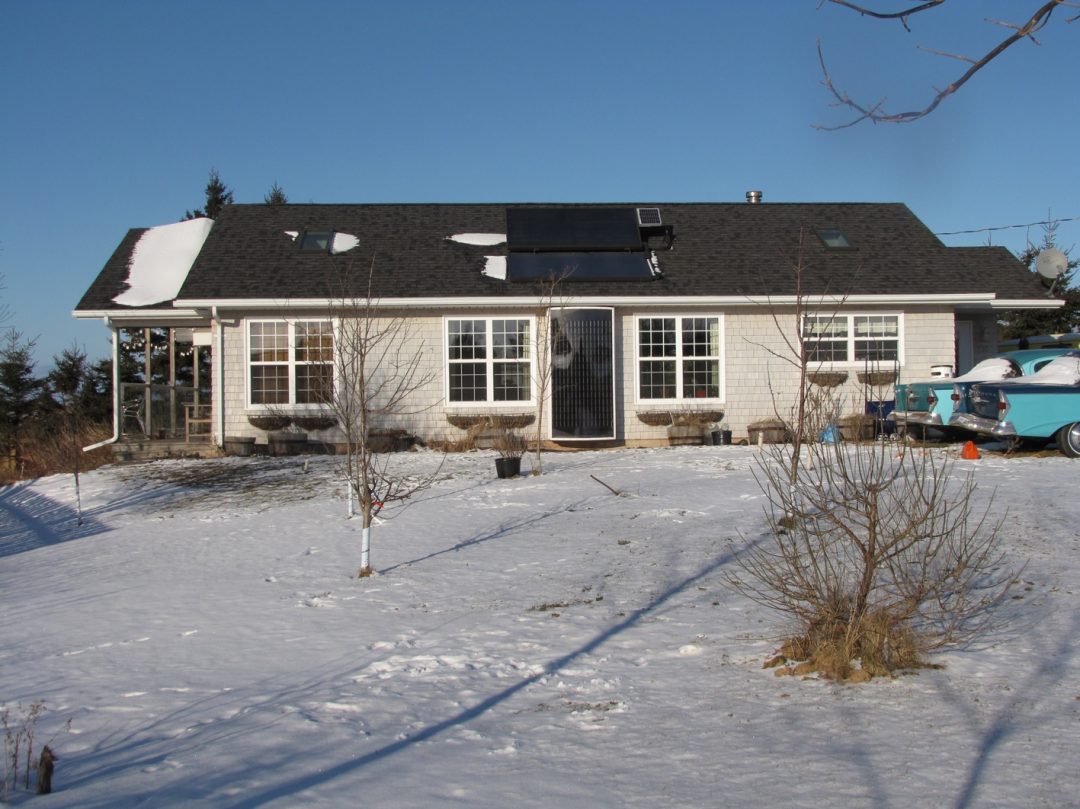His house on Prince Edward island

I received this note from a Canadian reader of my book, Energy Independence:
“I just finished your 2009 updated version, and I must say I liked it a lot. Obvious you are a word professional, as it flows so nicely, is understandable, and gets across lots of ideas that are neither too technical nor too overly simplified. You explain what I have been doing, much better than I could ever do!
“I live in Prince Edward Island, and started getting concerned some years ago about the changing climate, especially when I noticed that the high tides were creeping up the low bridges that I drive over all the time. I moved here from Ontario in 1993, because I couldn’t stand the “must have AC in summer” climate up there. Its green, peaceful, and quite rural here. Now, we are having higher tides regularly, and it is getting milder in winter, and hotter in summer.
“Actually, about 1975, a friend and senior scientist with Fisheries and Oceans Canada remarked in an offhand way at a gathering, “don’t worry too much about acid rain–I’m much more concerned about the rising ocean temperatures and what that will mean.” We lived in the snow belt of Ottawa Ontario at the time, and as the group of us all belonged to an organization re-introducing mainly nut trees that had been extirpated. We were glad to hear that Ottawa might be warmer in 50 years, so we should get busy and start planting pecans everywhere. He was gloomy though, and added something to the effect that we wouldn’t like it, and would be going snowy/cold or hot/sunny climate (second sunniest year round major area in Canada, after Northern Saskatchewan), to more like Seattle–no snow, lots of bugs, and it might rain 300 days a year, with also a possibility of some wild weather during the change years.
“So, here is what I’ve done. (I’ll put this all in US terms rather than metric)
* got rid of a thirsty Jeep (17 mpg) for a USED 2003 (in 2009) VW diesel wagon, that averages 54 mpg summer, and 45 winter. Still chugging along at about 150,000 miles now, so my crude oil use is 1/3 what it was.
* when I built my new house, I aligned it due solar south for midwinter. Its not an expensive house or anything really unusual except in the little details, and it cost me just over $100 sq/ft to have it built with my ‘tweaks’
* small windows on the north, (seawards) and east, and large windows on south and west. High E windows. House is built on an insulated concrete slab (ie, just like a traditional foundation, but upside down so there is no basement)
* high efficiency oil fired boiler furnace recycled from my old house. new house has infloor warm water heating rather than baseboard radiators, so that I can set the temperature much lower than before and be even more comfortable because it is now more radiant heat than covected heat. 67F is now more comfortable and less drafty than 72F was, and the temperature at the ceiling is only about 3 degrees warmer than the ‘me’ temperature.
* have a solar air heater panel on the south wall of the house. It provides my spring and fall heat, and a good portion of my winter heat. In my old house, same site, it was 4+ tanks of oil a year, heat and hot water (ie, over 1,000 US gallons). The solar air panal (Cansolair) paid its $3000 cost in two years flat. It only weighs 96 pounds, and attaches with 4 woodscrews to the outside wall, and best of all, it uses less than $10 of electricity a year to replace $1500 worth of oil.
* After I built my new house in 2007, I installed a solar hot water system (Nova Scotia Boiler, by Thermo Dymanics Inc in Nova Scotia) While the all in cost was higher (about $6,000-$7,000) I have lots of hot water summer and winter. I now use the dishwaher almost daily, and use the warm and hot cycles again on the washer. Deep baths and showers don’t have to skimped on, and the running cost is nil for 15 years, when the antifreeze has to be changed. It was a PV panel to generate electricity for the circular pump. It works even on overcast days to a certain extent, and I have normally a ‘3 cloudy day’ supply on hand. It has an electric backup, but I never use it. In fact, I discovered that the one time that I needed it, that the backup had been malfuntioning for a technical reason since it was installed in 2009! It saves me about $1500 in heating oil each year-the electricity equivalent would be about $1200 or more. Electricity cost me 12.65 kw/h, plus a monthly access fee of about $30.
* My oil heat is about 160 US gallons for all last winter (less than a tank–2/3)
* I used a Kill-a-Watt meter borrowed by my local public library, and started cutting electricity too. I now have power bars for all computers, printers, TV, satellite dish and controller, stereos, and turn them off at the switch unless they are in use.* replaced virtually all incandescent bulbs. There are a few left in fridge, stove, microwave, and dryer. Mostly LED (downwards) or CFL (facing upwards), and the remaining halogen will become LED shortly. I have been running at about 6.6/h per day average for the last 3 months, which includes freezer, refrigerator, washer, dishwasher, lights, media, computers, microwave, Venmar, fans, and sometimes the dryer.
* use the new outdoor line summer and winter–dryer used for bad weather only, or to remove lint etc without heat.* have a propane range now <ggg> love it!
“So my foot print is now:
* about 160 gallons of heating oil, down from about 1,000 a decade or so ago.
* about 200 gallons of diesel instead of 600 gallons of gasoline a year, ie 900-1100 miles a month, outside of special trips
* about 35 gallons of propane a year.
* about 3000 kw/h year or less, down from over 6000 6 years ago, and over 4000 last year.
“The next two projects
2012 installing about 8-10 PV solar electric panels, for net metering.
2015 installing a second solar hot water system, and get rid of furnace/oil tank.”
